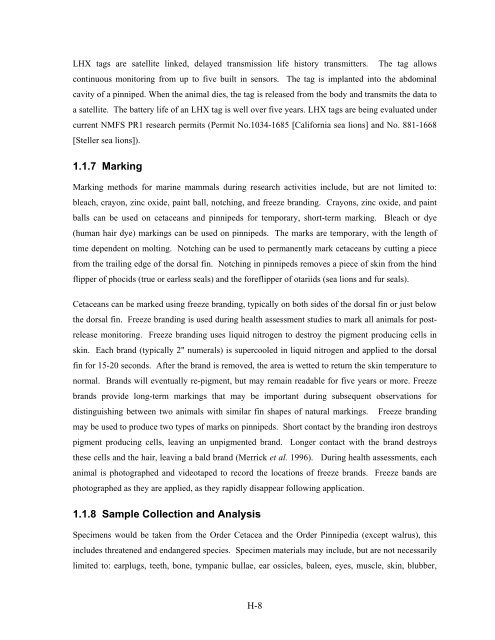Volume III, Appendices EM - National Marine Fisheries Service ...
Volume III, Appendices EM - National Marine Fisheries Service ...
Volume III, Appendices EM - National Marine Fisheries Service ...
Create successful ePaper yourself
Turn your PDF publications into a flip-book with our unique Google optimized e-Paper software.
LHX tags are satellite linked, delayed transmission life history transmitters. The tag allows<br />
continuous monitoring from up to five built in sensors. The tag is implanted into the abdominal<br />
cavity of a pinniped. When the animal dies, the tag is released from the body and transmits the data to<br />
a satellite. The battery life of an LHX tag is well over five years. LHX tags are being evaluated under<br />
current NMFS PR1 research permits (Permit No.1034-1685 [California sea lions] and No. 881-1668<br />
[Steller sea lions]).<br />
1.1.7 Marking<br />
Marking methods for marine mammals during research activities include, but are not limited to:<br />
bleach, crayon, zinc oxide, paint ball, notching, and freeze branding. Crayons, zinc oxide, and paint<br />
balls can be used on cetaceans and pinnipeds for temporary, short-term marking. Bleach or dye<br />
(human hair dye) markings can be used on pinnipeds. The marks are temporary, with the length of<br />
time dependent on molting. Notching can be used to permanently mark cetaceans by cutting a piece<br />
from the trailing edge of the dorsal fin. Notching in pinnipeds removes a piece of skin from the hind<br />
flipper of phocids (true or earless seals) and the foreflipper of otariids (sea lions and fur seals).<br />
Cetaceans can be marked using freeze branding, typically on both sides of the dorsal fin or just below<br />
the dorsal fin. Freeze branding is used during health assessment studies to mark all animals for postrelease<br />
monitoring. Freeze branding uses liquid nitrogen to destroy the pigment producing cells in<br />
skin. Each brand (typically 2" numerals) is supercooled in liquid nitrogen and applied to the dorsal<br />
fin for 15-20 seconds. After the brand is removed, the area is wetted to return the skin temperature to<br />
normal. Brands will eventually re-pigment, but may remain readable for five years or more. Freeze<br />
brands provide long-term markings that may be important during subsequent observations for<br />
distinguishing between two animals with similar fin shapes of natural markings. Freeze branding<br />
may be used to produce two types of marks on pinnipeds. Short contact by the branding iron destroys<br />
pigment producing cells, leaving an unpigmented brand. Longer contact with the brand destroys<br />
these cells and the hair, leaving a bald brand (Merrick et al. 1996). During health assessments, each<br />
animal is photographed and videotaped to record the locations of freeze brands. Freeze bands are<br />
photographed as they are applied, as they rapidly disappear following application.<br />
1.1.8 Sample Collection and Analysis<br />
Specimens would be taken from the Order Cetacea and the Order Pinnipedia (except walrus), this<br />
includes threatened and endangered species. Specimen materials may include, but are not necessarily<br />
limited to: earplugs, teeth, bone, tympanic bullae, ear ossicles, baleen, eyes, muscle, skin, blubber,<br />
H-8
















